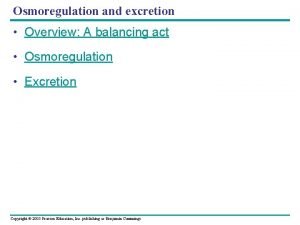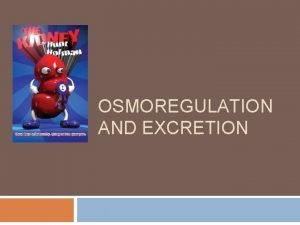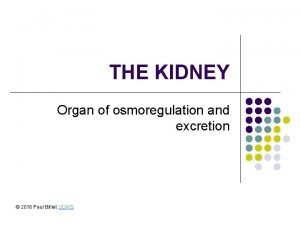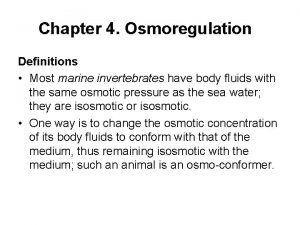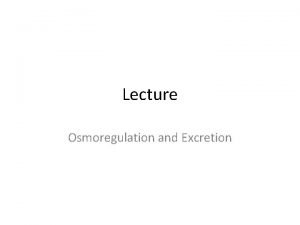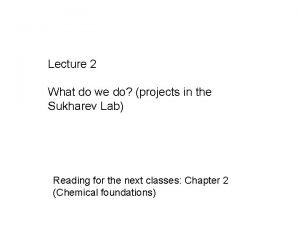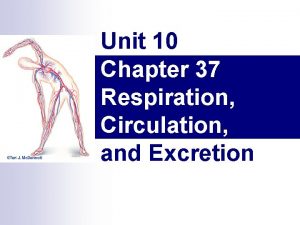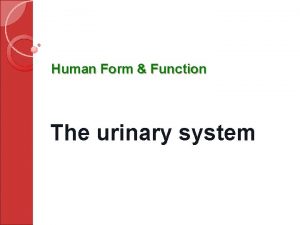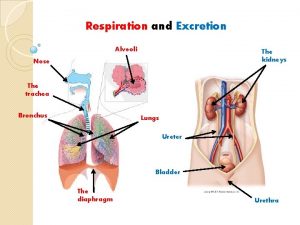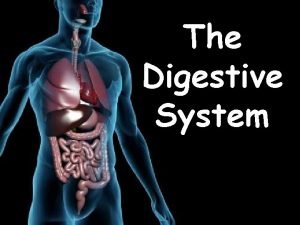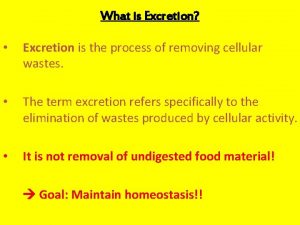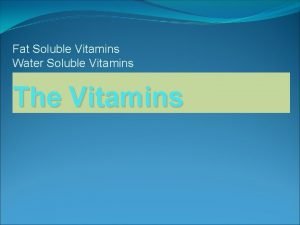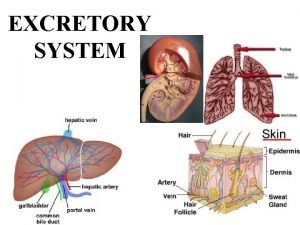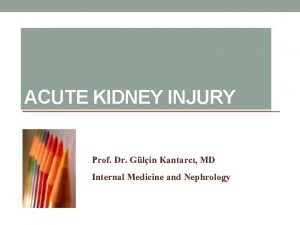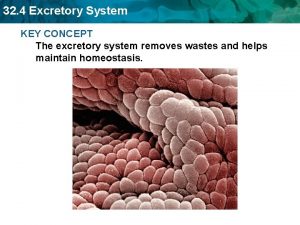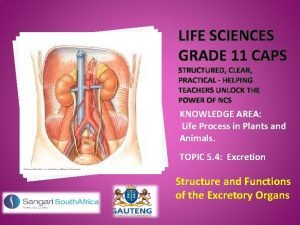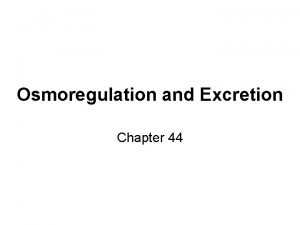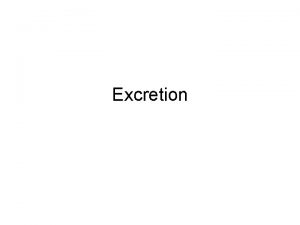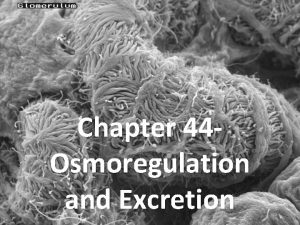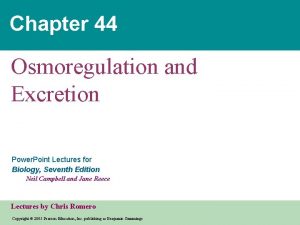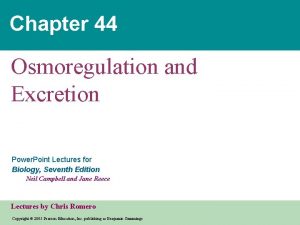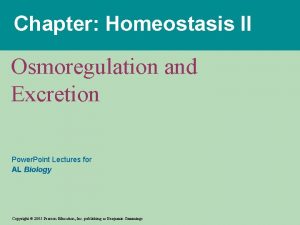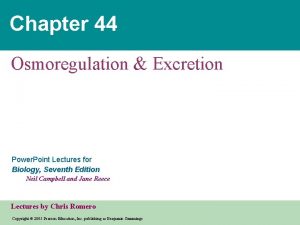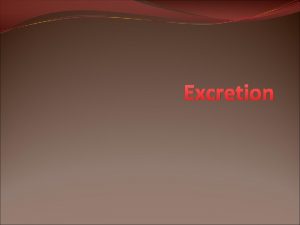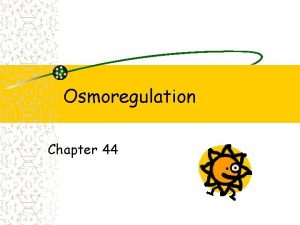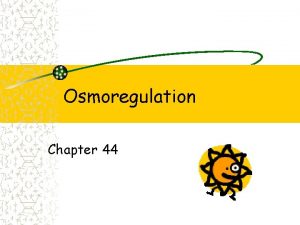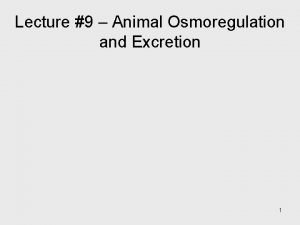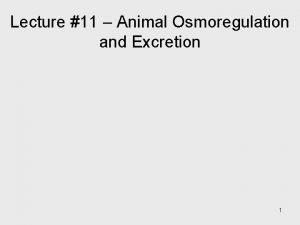Chapter 44 Osmoregulation and Excretion Power Point Lecture





























- Slides: 29

Chapter 44 Osmoregulation and Excretion Power. Point® Lecture Presentations for Biology Eighth Edition Neil Campbell and Jane Reece Lectures by Chris Romero, updated by Erin Barley with contributions from Joan Sharp Copyright © 2008 Pearson Education, Inc. , publishing as Pearson Benjamin Cummings

Overview: A Balancing Act • Physiological systems of animals operate in a fluid environment. • Relative concentrations of water and solutes must be maintained within fairly narrow limits. • Osmoregulation regulates solute concentrations and balances the gain and loss of water. Copyright © 2008 Pearson Education Inc. , publishing as Pearson Benjamin Cummings

• Freshwater animals show adaptations that reduce water uptake and conserve solutes. • Desert and marine animals face desiccating environments that can quickly deplete body water. • Excretion gets rid of nitrogenous metabolites and other waste products. Copyright © 2008 Pearson Education Inc. , publishing as Pearson Benjamin Cummings

Osmoregulation balances the uptake and loss of water and solutes • Osmoregulation is based largely on controlled movement of solutes between internal fluids and the external environment. Cells require a balance between osmotic gain and loss of water. • Osmolarity = the solute concentration of a solution, determines the movement of water across a selectively permeable membrane. • If two solutions are isoosmotic, the movement of water is equal in both directions. • If two solutions differ in osmolarity, the net flow of water is from the hypoosmotic to the hyperosmotic solution. Copyright © 2008 Pearson Education Inc. , publishing as Pearson Benjamin Cummings

Solute concentration and osmosis Selectively permeable membrane Solutes Net water flow Water Hyperosmotic side Hypoosmotic side

Osmotic Challenges • Osmoconformers, consisting only of some marine animals, are isoosmotic with their surroundings and do not regulate their osmolarity. • Osmoregulators expend energy to control water uptake in a hypoosmotic environment and loss in a hyperosmotic environment. Copyright © 2008 Pearson Education Inc. , publishing as Pearson Benjamin Cummings

• Most animals are stenohaline; they cannot tolerate substantial changes in external osmolarity. • Euryhaline animals can survive large fluctuations in external osmolarity. Copyright © 2008 Pearson Education Inc. , publishing as Pearson Benjamin Cummings

Marine Animals • Most marine invertebrates are osmoconformers. • Most marine vertebrates and some invertebrates are osmoregulators. • Marine bony fishes are hypoosmotic to sea water. They lose water by osmosis and gain salt by diffusion and from food. • They balance water loss by drinking seawater and excreting salts. Copyright © 2008 Pearson Education Inc. , publishing as Pearson Benjamin Cummings

Osmoregulation in marine and freshwater bony fishes: a comparison: drinking, gills, urine … Gain of water and Excretion Osmotic water salt ions from food of salt ions loss through gills and other parts from gills of body surface Gain of water and salt ions from drinking seawater Excretion of salt ions and small amounts of water in scanty urine from kidneys Osmoregulation in a saltwater fish Uptake of water and some ions in food Uptake Osmotic water of salt ions gain through gills and other parts by gills of body surface Excretion of large amounts of water in dilute urine from kidneys Osmoregulation in a freshwater fish

Freshwater Animals • Freshwater animals constantly take in water by osmosis from their hypoosmotic environment. • They lose salts by diffusion and maintain water balance by excreting large amounts of dilute urine. • Salts lost by diffusion are replaced in foods and by uptake across the gills. Copyright © 2008 Pearson Education Inc. , publishing as Pearson Benjamin Cummings

Animals That Live in Temporary Waters • Some aquatic invertebrates in temporary ponds lose almost all their body water and survive in a dormant state. • This adaptation is called anhydrobiosis. Copyright © 2008 Pearson Education Inc. , publishing as Pearson Benjamin Cummings

Anhydrobiosis - adaptation… Hydrated = active state dehydrated = dormant state. 100 µm (a) Hydrated tardigrade (b) Dehydrated tardigrade

Land Animals • Land animals manage water budgets by drinking and eating moist foods and using metabolic water. • Desert animals get major water savings from simple anatomical features and behaviors such as a nocturnal life style. Copyright © 2008 Pearson Education Inc. , publishing as Pearson Benjamin Cummings

Water balance in two terrestrial mammals Water balance in a kangaroo rat (2 m. L/day) Ingested in food (0. 2) Water gain (m. L) Water balance in a human (2, 500 m. L/day) Ingested in food (750) Ingested in liquid (1, 500) Derived from metabolism (250) Derived from metabolism (1. 8) Feces (0. 09) Water loss (m. L) Urine (0. 45) Evaporation (1. 46) Feces (100) Urine (1, 500) Evaporation (900)

Energetics of Osmoregulation • Osmoregulators must expend energy to maintain osmotic gradients. Animals regulate the composition of body fluid that bathes their cells. • Transport epithelia are specialized epithelial cells that regulate solute movement. • They are essential components of osmotic regulation and metabolic waste disposal. They are arranged in complex tubular networks • An example is in salt glands of marine birds, which remove excess sodium chloride from the blood. Copyright © 2008 Pearson Education Inc. , publishing as Pearson Benjamin Cummings

How do seabirds eliminate excess salt from their bodies? EXPERIMENT Ducts Nasal salt gland Nostril with salt secretions

Vein Artery Secretory tubule Salt gland Secretory cell Countercurrent Capillary exchange in Secretory tubule salt-excreting Transport nasal glands epithelium Na. Cl Direction of salt movement Central duct (a) Blood flow (b) Salt secretion

An animal’s nitrogenous wastes reflect its phylogeny and habitat • The type and quantity of an animal’s waste products may greatly affect its water balance. • Among the most important wastes are nitrogenous breakdown products of proteins and nucleic acids. • Some animals convert toxic ammonia (NH 3) to less toxic compounds prior to excretion. Copyright © 2008 Pearson Education Inc. , publishing as Pearson Benjamin Cummings

Nitrogenous wastes Proteins Amino acids Nucleic acids Nitrogenous bases Amino groups Most aquatic animals, including most bony fishes Ammonia Very toxic Mammals, most Many reptiles amphibians, sharks, (including birds), some bony fishes insects, land snails Urea - less toxic Uric acid - not soluble

Animals Excrete Different Forms of Nitrogenous Wastes • Ammonia - needs lots of water. Animals release ammonia across whole body surface or through gills / aquatic animals. • Urea - The liver of mammals and most adult amphibians converts ammonia to less toxic urea. The circulatory system carries urea to kidneys, where it is excreted. Conversion of ammonia to urea is energetically expensive; uses less water than ammonia. Copyright © 2008 Pearson Education Inc. , publishing as Pearson Benjamin Cummings

Nitrogenous Wastes … • Uric Acid - Insects, land snails, and many reptiles, including birds, mainly excrete uric acid. Uric acid is largely insoluble in water; can be secreted as a paste with little water loss. Uric acid is more energetically expensive to produce than urea. • The kinds of nitrogenous wastes excreted depend on an animal’s evolutionary history and habitat. • The amount of nitrogenous waste is coupled to the animal’s energy budget. Copyright © 2008 Pearson Education Inc. , publishing as Pearson Benjamin Cummings

Diverse excretory systems are variations on a tubular theme Excretory systems regulate solute movement between internal fluids and the external environment. Most excretory systems produce urine by refining a filtrate derived from body fluids. Key functions of most excretory systems: – Filtration: pressure-filtering of body fluids – Reabsorption: reclaiming valuable solutes – Secretion: adding toxins and other solutes from the body fluids to the filtrate – Excretion: removing the filtrate from the system. Copyright © 2008 Pearson Education Inc. , publishing as Pearson Benjamin Cummings

Key functions of excretory systems: an overview Filtration Capillary Blood --> tubule Filtrate Excretory tubule Reabsorption Tubule --> blood Secretion Urine Excretion

Survey of Excretory Systems • Systems that perform basic excretory functions vary widely among animal groups. They usually involve a complex network of tubules. • Protonephridia flame cells / planaria • Metanephridia earthworm / similar to nephrons • Malpighian Tubules insects • Nephrons = the function unit of the kidneys / humans. Copyright © 2008 Pearson Education Inc. , publishing as Pearson Benjamin Cummings

Protonephridia • A protonephridium is a network of dead-end tubules connected to external openings. • The smallest branches of the network are capped by a cellular unit called a flame bulb. • These tubules excrete a dilute fluid and function in osmoregulation. Copyright © 2008 Pearson Education Inc. , publishing as Pearson Benjamin Cummings

Protonephridia: the flame bulb system of a planarian Nucleus of cap cell Flame bulb Cilia Interstitial fluid flow Tubules of protonephridia Opening in body wall Tubule cell

Metanephridia • Each segment of an earthworm has a pair of open-ended metanephridia. • Metanephridia consist of tubules that collect coelomic fluid and produce dilute urine for excretion. Copyright © 2008 Pearson Education Inc. , publishing as Pearson Benjamin Cummings

Metanephridia of an earthworm Coelom Capillary network Components of a metanephridium: Internal opening Collecting tubule Bladder External opening

Malpighian Tubules • In insects and other terrestrial arthropods, Malpighian tubules remove nitrogenous wastes from hemolymph and function in osmoregulation. • Insects produce a relatively dry waste matter, an important adaptation to terrestrial life. Copyright © 2008 Pearson Education Inc. , publishing as Pearson Benjamin Cummings
 Tonicity and osmoregulation
Tonicity and osmoregulation Osmoregulation
Osmoregulation Protonephridia
Protonephridia Osmoregulation
Osmoregulation Renal artery branches
Renal artery branches Osmoregulation in invertebrates
Osmoregulation in invertebrates Osmoregulation
Osmoregulation Osmoregulation
Osmoregulation Osmoregulation in plants
Osmoregulation in plants Chapter 37 respiration circulation and excretion
Chapter 37 respiration circulation and excretion 01:640:244 lecture notes - lecture 15: plat, idah, farad
01:640:244 lecture notes - lecture 15: plat, idah, farad Excretion and elimination
Excretion and elimination Respiration and excretion
Respiration and excretion Rugae
Rugae Digestion and excretion lesson 3
Digestion and excretion lesson 3 Triangle of power
Triangle of power Power bi training powerpoint
Power bi training powerpoint Point point power
Point point power What is excretion
What is excretion Zeroth order kinetics
Zeroth order kinetics Vitamin water history
Vitamin water history What is excretion
What is excretion What is excretion
What is excretion Fena formula
Fena formula Excretory system
Excretory system Nicotine excretion
Nicotine excretion What is excretion
What is excretion Vitamin e excretion
Vitamin e excretion Grade 11 excretion
Grade 11 excretion Seeds travel
Seeds travel

